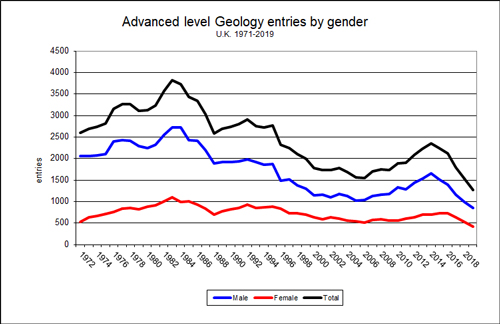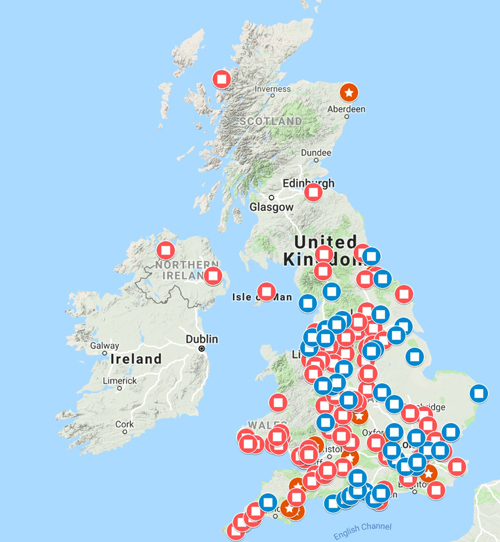Geoscience is critical for meeting the sustainable development goals, yet student numbers are dwindling. Dan Boatright, Sian Davies-Vollum and Chris King urge the geoscience community to make geology more visible on the curriculum
Boatright, D., Davies-Vollum, S. & King, C., Earth science education: The current state of play.
Geoscientist 29 (8), 16-19, 2019
https://doi.org/10.1144/geosci2019-045;
Download the pdf here

The importance of what we learn at school must not be overlooked. In the UK, students face decisions about their future from the age of 14: What GCSEs should they study? What career paths should they follow? Where should they undertake further study? If an individual is not exposed to the breadth of study and career alternatives at a young age, how can they make informed decisions about their future?
This is the situation geology faces. While as children we may have had a rock collection, or been obsessed with dinosaurs, early exposure to geology is generally limited. If we want to inspire the next generation of geologists, we must ensure that Earth science is visible in the curriculum. Currently, this is not the case. Geology is randomly integrated into different subjects; it is occasionally found in a geography class, and sometimes in chemistry or physics. Consequently, geology is often an afterthought in the classroom, with many teachers feeling uncomfortable with teaching the content, and others frustrated by the lack of substantial Earth science. As a result, we find that the numbers of students studying General Certificate of Secondary Education (GCSE) and Advanced (A)-level geology are in serious decline, and the numbers in universities are now following the same trend.
A brief history
Times have changed since the heyday of geology teaching in schools and colleges. In the 1980s, there were almost 4,000 entries for A-level geology, more than 8,000 entries for GCSE geology and several exam boards offered the subject (data from the Earth Science Teachers’ Association, ESTA;
https://earthscience.org.uk/). Geology teachers were trained at six institutions around the country. However, with the introduction of the National Curriculum in the late 1980s, a steady decline in both the GCSE and the A level followed.
A-level geology experienced a brief renaissance in the mid-2000s. Anecdotal evidence suggests that this was due to the introduction of the four Advanced Subsidiary (AS)-level system, with numerous students choosing AS-level geology as their fourth subject. Many then continued studying geology at A-level (Fig. 1). However, this trend has since been reversed, as A-level funding has been reduced and we return to the three A-level system.
 Figure 1: UK A-level geology entries, 1971-2019
Figure 1: UK A-level geology entries, 1971-2019
Similarly, the introduction of a new, modernised and more relevant geology syllabus in the mid-2000s saw GCSE entries rise. However, this increase came to a shuddering halt in 2015, when Government introduced the Progress 8 initiative. Within Progress 8, geology is not counted as a science and so plays a minor role in the school league tables. There is now little ambition within schools to offer minority subjects. This perfect storm has brought us towards a cliff edge, with students less likely to be offered geology GCSE and unable to take a fourth subject as they undertake AS levels, fewer students are therefore taking geology A-level. From a high of 4,000 in the early 1980s, A-level entry to geology courses had fallen to 1,525 in 2018 (Fig. 1) with only two exam boards offering it.
The role of the A level should not be overlooked. Information from the Universities and Colleges Admissions Service (UCAS) showed that more than 40% of the applicants for undergraduate geology degrees had A-level geology (UCAS provided data for 2010, when 44% of applicants had A-level geology, and for 2012, when the figure was 43%. Since then, no data have been available from UCAS). Meanwhile research carried out by ESTA between 2009 and 2014 showed that 44% of students who gained A-level geology and went on to university, studied for a geoscience degree (data from 39 centres). These figures show that A-level geology is a critical recruiter for undergraduate geology degrees.
Anecdotal evidence from teachers working in Scotland, where Higher Geology used to be taught, suggests that it was not the interest of the school students that declined, but the availability of geology teachers (the last to be trained in Scotland was in 1966). So, when the two remaining institutions training geology teachers in England closed, ESTA took steps to offer training in geology teaching to practicing or newly-qualified teachers of science or geography who had geology degrees. This training is offered at an intensive seven-day Summer School Masters (M)-level course at Keele University (
www.keele.ac.uk/tlge-module). The course is provided free-of-charge to participants, thanks to industrial bursaries, and eight geology teachers have been trained per year for the past four years. By maintaining the supply of geology teachers, we hope to continue offering geology in schools and colleges across the UK, but further funding is needed to ensure we can continue in future years.
The Higher Education perspective
The Geological Society currently recognises 37 English, five Scottish and four Welsh Higher Education institutions that offer undergraduate and/or postgraduate degrees in the broad subject area of geoscience. These include degrees as diverse as a Bachelor of Science (Hons) in Environmental Earth Sciences, a Master of Science in Remote Sensing and Planetary Science and a Bachelor of Engineering (Hons) in Engineering Geology and Geotechnics. The diversity of degrees designated as ‘geoscience’ highlights the interdisciplinary nature of the subject and the ability of geology to make connections and contributions across the social and natural sciences.
Fieldwork is arguably the key element that distinguishes geology graduates from their peers, providing them with unparalleled experiences in resilience, adaptability and project management—all highly valued skills in any employment sector. Geoscience undergraduate and postgraduate degrees are clearly and increasingly allied to industry and employment. Most Masters degrees have an applied focus and many geoscience degrees can be studied as a four-year option, with a year in industry.
Despite these positive aspects, recruitment to geoscience degrees at UK universities is on a downward trajectory. Nationally, applications to geology programmes are down 9% (2018-2019) following a drop of 11% in 2017-2018 (for comparison marine and environmental sciences were up 10% this year). There were only 1,100 enrolments onto geology programmes in 2018-19, compared with 1,800 in 2014-2015. With the decreasing number of geology A-level entrants, and the challenge we have in attracting A-level students who have not previously studied geology, the trend looks set to continue (
https://www.ucas.com/data-and-analysis).
The very nature of the subject itself is threatened as the UK’s Teaching Excellence Framework (TEF) struggles to establish where geology best fits. Originally placed in the physical sciences, alongside forensic and materials science, geology has now been placed with geography and environmental science, a group less likely to receive Science, Technology, Engineering and Mathematics (STEM) recognition. The possibility of the Augar review (the UK government’s current review of post-18 education) advocating reductions to student university fees with a government-funded ‘top up’ for STEM subjects, places geology in a very precarious position if it is categorised as non-STEM.
Geoscience has a critical contribution to make to the energy transition from fossil to renewable energy sources, and it has a key role in addressing the challenges of sustainability. Geology contributes to the UK Government Industrial Strategy, the 25 Year Environment Plan and the Clean Growth Strategy. This is a critical time for geology. In schools and colleges it could dwindle as a standalone subject, and in higher education the STEM-status could be lost and student numbers could continue on their downward trajectory. We urge geologists in industry, government and education to work together to raise the profile of the subject and to alter the public perception of what geoscientists do and of the significant contribution they make to society.
The future
The Earth Science Teachers’ Association (ESTA) has worked to promote the teaching of geology and Earth sciences for over fifty years. As a charity, it has relied heavily on the free time of willing volunteers to guide the organisation and ensure teachers have the support to teach the subject effectively. Running a conference every year, the charity has built a strong relationship with universities and learned organisations. ESTA is now attempting to incorporate the teacher training and training workshops of the now disbanded Earth Science Education Unit, led by Prof. Chris King at Keele University. At the same time, Universities Geoscience UK (
https://www.geolsoc.org.uk/UniversityGeoscienceUK), the association of geoscience departments and schools based within UK universities, is working with ESTA and other geological organisations and associations to raise the profile of geology, highlight geological careers and contemporise the often-outmoded public perceptions of what it means to be a geologist.
The reduction in schools and colleges offering geology threatens our subject. The map in figure 2 shows a broad distribution of centres currently teaching GCSE or A-level geology in the UK, but very often class sizes are small, putting the subject at risk as schools and colleges consider cuts. With declining numbers of teachers and an ever-declining pool of talent from which to find new teachers, funding has had to become a focus. ESTA has started to develop closer links with corporate affiliates, patrons and learned associations, and looks forward to hearing from those who are interested in preserving geology in schools and college.
 Figure 2: Centres teaching examination-level geology in 2018. Eduqas (part of the Welsh Joint Education Committee; WJEC) GCSE geology, red stars; Eduqas A-level geology, red squares; Oxford, Cambridge and Royal Society of Arts (OCR) specification geology, blue squares. Published by Earth Science Teachers’ Association (ESTA) here (Map data ©2019 GeoBasis-DE/BKG (©2009), Google, Inst. Geogr. Nacional)
Figure 2: Centres teaching examination-level geology in 2018. Eduqas (part of the Welsh Joint Education Committee; WJEC) GCSE geology, red stars; Eduqas A-level geology, red squares; Oxford, Cambridge and Royal Society of Arts (OCR) specification geology, blue squares. Published by Earth Science Teachers’ Association (ESTA) here (Map data ©2019 GeoBasis-DE/BKG (©2009), Google, Inst. Geogr. Nacional)
Educating the next generation of geology teachers, and promoting geology to school and college leaders, requires a new approach to funding and we have developed a range of membership categories to help different groups contribute to Earth science education. While we have experienced a difficult few years, geology education has the potential to grow and strengthen, with all levels of education working together. From primary to higher education, we have a strong and committed community, but we need to work with industry and learned societies like the Geological Society, to ensure geology remains in schools for years to come.
Dr Dan Boatright, Geography and Geology Teacher, District Councillor and Chair of the Earth Science Teachers Association; e-mail: [email protected]
Dr K. Sian Davies-Vollum Head of School of Environmental Sciences University of Derby; Executive Secretary UGUK; e-mail: [email protected]
Professor Chris King, Emeritus Professor of Earth Science, Keele University; e-mail: [email protected]
Want to know more? Visit our website:
https://earthscience.org.uk/
Further reading
Universities Geoscience UK;
https://www.geolsoc.org.uk/UniversityGeoscienceUK
The Teaching Excellence Framework (TEF);
https://www.gov.uk/government/collections/teaching-excellence-framework
The Augar review;
https://www.gov.uk/government/publications/post-18-review-of-education-and-funding-independent-panel-report
The Government Industrial Strategy;
https://www.gov.uk/government/topical-events/the-uks-industrial-strategy
The 25 Year Environment Plan;
https://www.gov.uk/government/publications/25-year-environment-plan
The Clean Growth Strategy;
https://www.gov.uk/government/publications/clean-growth-strategy
Top image by GLady from Pixabay